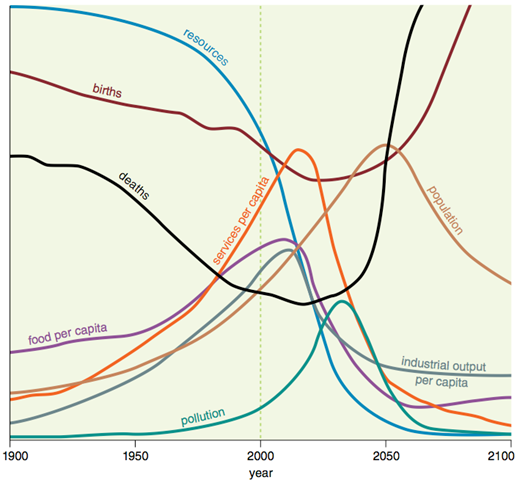The Limits to Growth at forty: Is collapse now inevitable?
By Mícheál O’Callaghan
18 January 2012 Forty years ago, a group of Scientists investigated what the world would look like if we continued on our path of exponential economic growth, with a continued growth in population, pollution and industry. The study resulted in the publishing of the eye opening book, The Limits to Growth, which would surely cause discomfort to even the most ardent of believers in the might of our growth dependent economic system. The team of scientists inputted various sets of data, based on differing predictions relating to population, pollution and economic growth into the World 3 computer model, which made calculations about the future trajectory of economic growth, in relation to any potential limits to such growth and the consequences of surpassing these limits. In almost all models, where growth continued exponentially, population and industry went into sharp decline following peak. The most revealing aspect of these models was that where growth continued, it eventually hit the natural and ecological limits to growth, where after it would undergo a steep rather than gentle and gradual decline, otherwise called a collapse. Collapse resulted even in models where an account was made for a potentially greatly increased use of renewable and nuclear energies, as well as higher farm yields or greater birth control. The underlying cause of this resultant collapse was the system of inter related feedbacks between the various aspects of the globalised system. For example, even when there was a great increase in renewable energies, collapse would eventually manifest itself due to increased population, soil erosion and general pollution. A particularly realistic aspect of these models was that it factored in the delayed response of individuals to the signs of imminent limits, as it accounted for the probability that people would continue to consume and pollute past the sustainable limits of the particular model. Of course, in the real world, many people will continue to consume until it is no longer possible. Could the models have predicted the true extent of the inaction that we have witnessed in the face of the grave threats of climate change, peak oil and bio – diversity loss? However, the study was not all doom and gloom. In a number of models, population and industrial growth were constrained, and as a result growth did in fact level out, rather than continue exponentially, resulting in a global collapse. The underlying message of the book was one of caution, as well as presenting a call of action to society. It showed the grave risks associated with continued, un – tapered, economic growth, but it presented a positive alternative where, if certain controls were put in place, people could live within the natural means of the planet and continue to benefit from the many advancements and developments of the industrial revolution, without the worry of impending collapse. According to the book, this collapse, if growth continued as it was then, could be expected within 100 years. Of course, forty years on, based on the book’s predictions, we can expect this collapse to manifest itself at some (uncertain) point in the next sixty years. Has anything changed, and have we managed to divert from the path towards collapse in the intervening forty years? Pause and think about this for a second. It doesn’t take a lot of analysis to realise that little has changed since the first publication of The Limits to Growth. Our economic system is still entirely dependent on the need for long term economic growth to survive, our food, economic and social structures are less resilient than ever before, the effects of Climate Change are becoming more prevalent with increased natural disasters, and we are teetering on the brink of global peak production of oil, the very life blood of our globalised, growth dependent system. All the while, our political leaders continue dither to about fairly weak, verbal agreements to do something about this predicament. The recent talks in Durban were a clear example of this, with politicians stating that they will agree the terms of a new Climate Agreement by 2015 with it coming into effect by 2020. Effectively they are saying, “Yeah this is important, but let’s not deal with it right now.” This is in spite of the fact that the International Energy Authority, has recently stated that we have five years in which to act to avoid irreversible Climate Change. The new treaty, if they ever agree on one, won’t even have taken effect within five years!! The team of Scientists behind The Limits to Growth have stated that they will not be engaging in a sequel to their study, as starting from current conditions, there is now no plausible assumptions other than over shoot. So, it doesn’t look particularly rosy in terms of avoiding collapse. However, there is still much that can be achieved to lessen the severity of our current predicament. While it may no longer be possible to attain a sustainable and manageable ‘tapering off’ of growth levels, there is still much that we can do to lessen the severity of the collapse. […]
